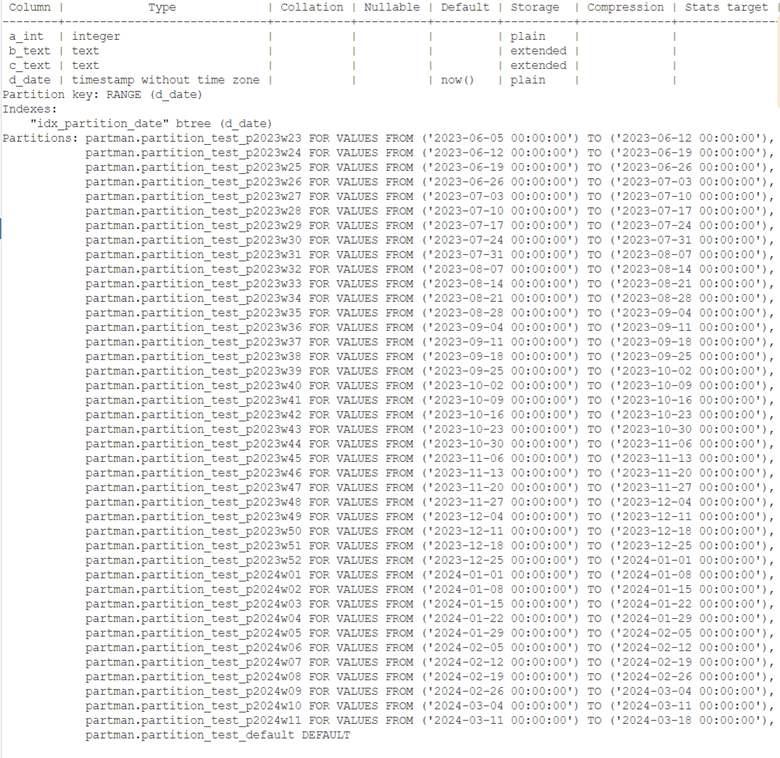Note
Access to this page requires authorization. You can try signing in or changing directories.
Access to this page requires authorization. You can try changing directories.
In this article, you learn how to optimize Azure Database for PostgreSQL flexible server by using the PostgreSQL Partition Manager (pg_partman) extension.
When tables in a database become large, it's hard to manage how often they're vacuumed, how much space they take up, and how to keep their indexes efficient. This difficulty can make queries slower and affect performance. Partitioning of large tables is a solution for these situations.
In this article, you use pg_partman to create range-based partitions of tables in your Azure Database for PostgreSQL flexible server.
Prerequisites
To enable the pg_partman extension, follow these steps:
In the Azure portal, select
pg_partmanin the list of server parameters forazure.extensions.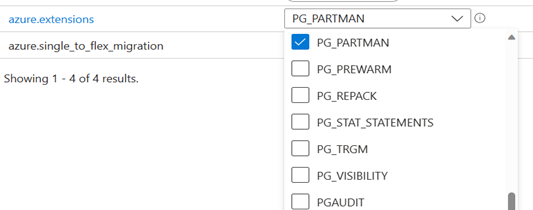
CREATE EXTENSION pg_partman;Include the related
pg_partman_bgwextension inshared_preload_libraries. It offers the scheduled functionrun_maintenance(). It takes care of the partition sets that haveautomatic_maintenanceset toONinpart_config.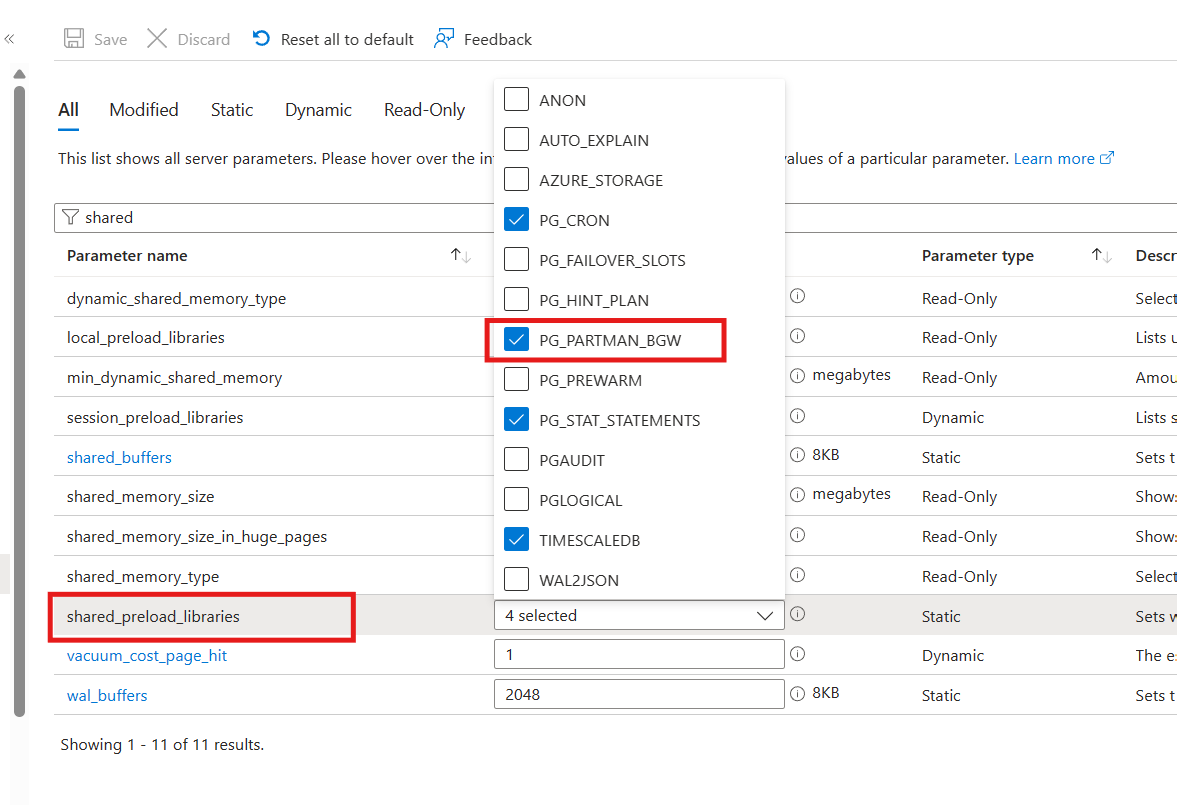
You can use server parameters in the Azure portal to change the following configuration options that affect the Background Writer (BGW) process:
pg_partman_bgw.dbname: Required. This parameter should contain one or more databases whererun_maintenance()needs to run. If there's more than one database, use a comma-separated list. If nothing is set,pg_partman_bgwdoesn't run the procedure.pg_partman_bgw.interval: The number of seconds between calls to therun_maintenance()procedure. Default is3600(1 hour). You can update this value based on the requirements of the project.pg_partman_bgw.role: The role thatrun_maintenance()procedure runs as. Default ispostgres. Only a single role name is allowed.pg_partman_bgw.analyze: Same purpose as thep_analyzeargument torun_maintenance(). By default, it's set toOFF.pg_partman_bgw.jobmon: Same purpose as thep_jobmonargument torun_maintenance(). By default, it's set toON.
Note
When an identity feature uses sequences, the data from the parent table gets new sequence values. It doesn't generate new sequence values when the data is directly added to the child table.
The
pg_partmanextension uses a template to control whether the table isUNLOGGED. This means theALTER TABLEcommand can't change this status for a partition set. By changing the status on the template, you can apply it to all future partitions. But for existing child tables, you must use theALTER TABLEcommand manually. This bug shows why.
Set up permissions
A superuser role isn't required with pg_partman. The only requirement is that the role that runs pg_partman functions has ownership over all the partition sets and schemas where new objects will be created.
We recommend that you create a separate role for pg_partman and give it ownership over the schema and all the objects that pg_partman will operate on:
CREATE ROLE partman_role WITH LOGIN;
CREATE SCHEMA partman;
GRANT ALL ON SCHEMA partman TO partman_role;
GRANT ALL ON ALL TABLES IN SCHEMA partman TO partman_role;
GRANT EXECUTE ON ALL FUNCTIONS IN SCHEMA partman TO partman_role;
GRANT EXECUTE ON ALL PROCEDURES IN SCHEMA partman TO partman_role;
GRANT ALL ON SCHEMA <partition_schema> TO partman_role;
GRANT TEMPORARY ON DATABASE <databasename> to partman_role; -- This allows temporary table creation to move data.
Create partitions
The pg_partman extension supports range-type partitions only, not trigger-based partitions. The following code shows how pg_partman assists with partitioning a table:
CREATE SCHEMA partman;
CREATE TABLE partman.partition_test
(a_int INT, b_text TEXT,c_text TEXT,d_date TIMESTAMP DEFAULT now())
PARTITION BY RANGE(d_date);
CREATE INDEX idx_partition_date ON partman.partition_test(d_date);

By using the create_parent function, you can set up the number of partitions that you want on the partition table:
SELECT public.create_parent(
p_parent_table := 'partman.partition_test',
p_control := 'd_date',
p_type := 'native',
p_interval := 'daily',
p_premake :=20,
p_start_partition := (now() - interval '10 days')::date::text
);
UPDATE public.part_config
SET infinite_time_partitions = true,
retention = '1 hour',
retention_keep_table=true
WHERE parent_table = 'partman.partition_test';
The preceding command divides p_parent_table into smaller parts based on the p_control column, by using native partitioning. (The other option is trigger-based partitioning, but pg_partman doesn't currently support it.) The partitions are created at a daily interval.
The example creates 20 future partitions in advance, instead of using the default value of 4. It also specifies p_start_partition, where you mention the past date from which the partitions should start.
The create_parent() function populates two tables: part_config and part_config_sub. There's a maintenance function, run_maintenance(). You can schedule a cron job for this procedure to run on a periodic basis. This function checks all parent tables in a part_config table and creates new partitions for them, or it runs the tables' set retention policy. To learn more about the functions and tables in pg_partman, see the PostgreSQL Partition Manager Extension documentation on GitHub.
To create new partitions every time the run_maintenance() is run in the background through the pg_partman_bgw extension, run the following UPDATE statement:
UPDATE partman.part_config SET premake = premake+1 WHERE parent_table = 'partman.partition_test';
If the premake is the same and your run_maintenance() procedure is run, no new partitions are created for that day. For the next day, because the premake defines from the current day, a new partition for a day is created with the execution of your run_maintenance() function.
By using the following INSERT INTO commands, insert 100,000 rows for each month:
INSERT INTO partman.partition_test SELECT GENERATE_SERIES(1,100000),GENERATE_SERIES(1, 100000) || 'abcdefghijklmnopqrstuvwxyz',
GENERATE_SERIES(1, 100000) || 'zyxwvutsrqponmlkjihgfedcba', GENERATE_SERIES (timestamp '2024-03-01',timestamp '2024-03-30', interval '1 day ') ;
INSERT INTO partman.partition_test SELECT GENERATE_SERIES(100000,200000),GENERATE_SERIES(100000,200000) || 'abcdefghijklmnopqrstuvwxyz',
GENERATE_SERIES(100000,200000) || 'zyxwvutsrqponmlkjihgfedcba', GENERATE_SERIES (timestamp '2024-04-01',timestamp '2024-04-30', interval '1 day') ;
INSERT INTO partman.partition_test SELECT GENERATE_SERIES(200000,300000),GENERATE_SERIES(200000,300000) || 'abcdefghijklmnopqrstuvwxyz',
GENERATE_SERIES(200000,300000) || 'zyxwvutsrqponmlkjihgfedcba', GENERATE_SERIES (timestamp '2024-05-01',timestamp '2024-05-30', interval '1 day') ;
INSERT INTO partman.partition_test SELECT GENERATE_SERIES(300000,400000),GENERATE_SERIES(300000,400000) || 'abcdefghijklmnopqrstuvwxyz',
GENERATE_SERIES(300000,400000) || 'zyxwvutsrqponmlkjihgfedcba', GENERATE_SERIES (timestamp '2024-06-01',timestamp '2024-06-30', interval '1 day') ;
INSERT INTO partman.partition_test SELECT GENERATE_SERIES(400000,500000),GENERATE_SERIES(400000,500000) || 'abcdefghijklmnopqrstuvwxyz',
GENERATE_SERIES(400000,500000) || 'zyxwvutsrqponmlkjihgfedcba', GENERATE_SERIES (timestamp '2024-07-01',timestamp '2024-07-30', interval '1 day') ;
Run the following command on PostgreSQL to see the created partitions:
\d+ partman.partition_test;
Here's the output of the SELECT statement that you ran:
Manually run a maintenance procedure
You can manually run the partman.run_maintenance() command instead of using pg_partman_bgw. Use the following command to run the maintenance procedure manually:
SELECT partman.run_maintenance(p_parent_table:='partman.partition_test');
Warning
If you insert data before creating partitions, the data goes to the default partition. If the default partition has data that belongs to a new partition that you want create later, you get a default partition violation error and the procedure doesn't work. Change the premake value recommended earlier and then run the procedure.
Schedule a maintenance procedure
Run the maintenance procedure by using pg_cron:
First, enable
pg_cronon your server. In the Azure portal, addpg_cronto theazure. extensions,shared_preload_libraries, andcron.database_nameserver parameters.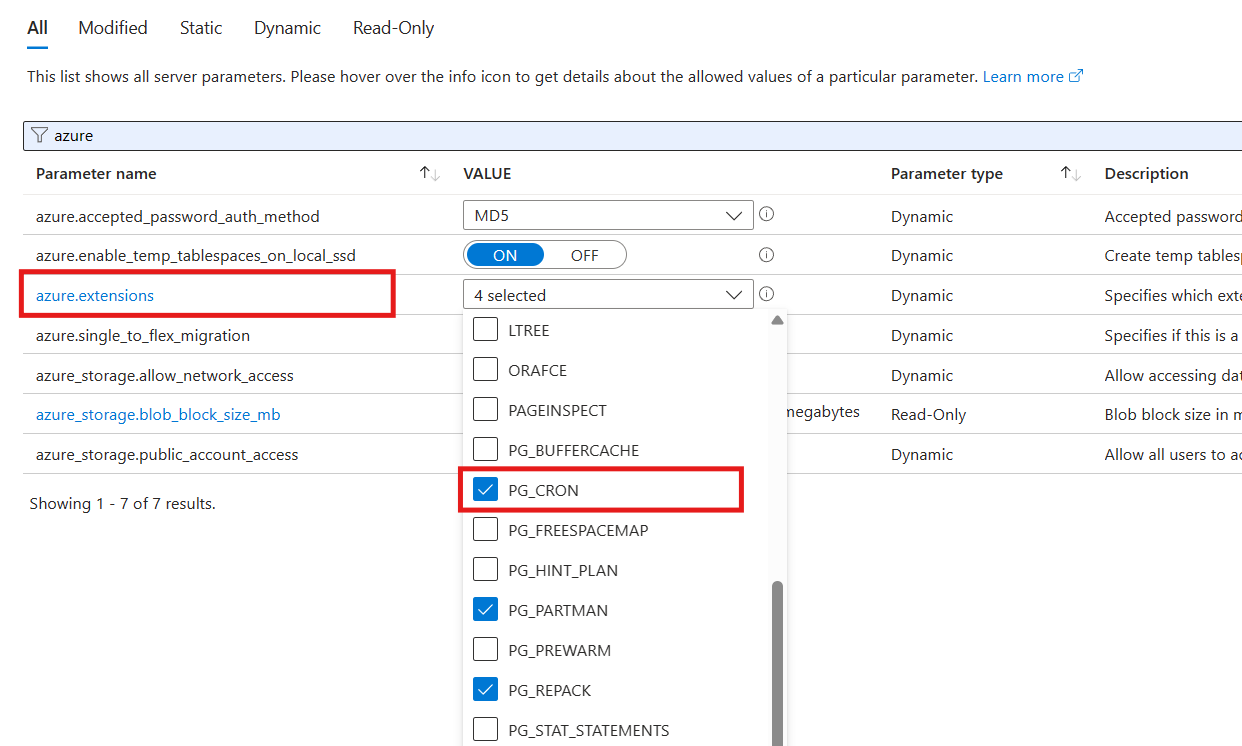
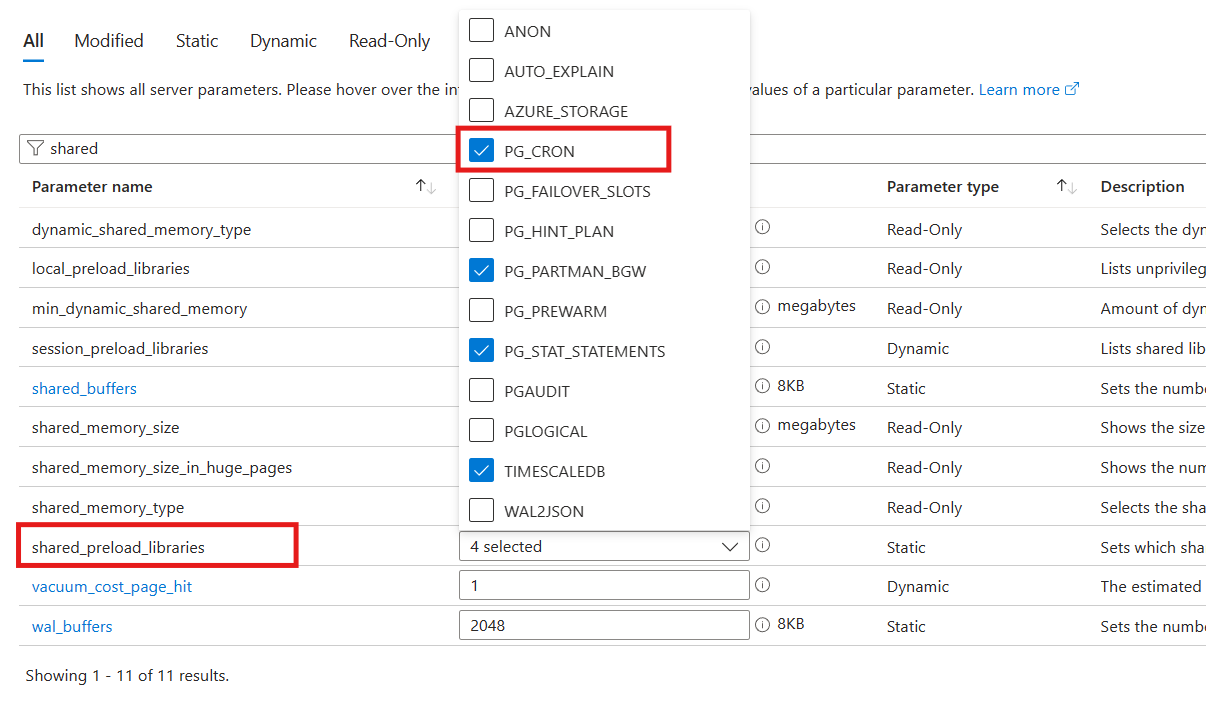

Select the Save button and let the deployment finish.
After the deployment finishes,
pg_cronis created automatically. If you try to install it, you get the following message:CREATE EXTENSION pg_cron;ERROR: extension "pg_cron" already existsTo schedule the
cronjob, use the following command:SELECT cron.schedule_in_database('sample_job','@hourly', $$SELECT partman.run_maintenance(p_parent_table:= 'partman.partition_test')$$,'postgres');To view all the
cronjobs, use the following command:SELECT * FROM cron.job;-[ RECORD 1 ]----------------------------------------------------------------------- jobid | 1 schedule | @hourly command | SELECT partman.run_maintenance(p_parent_table:= 'partman.partition_test') nodename | /tmp nodeport | 5432 database | postgres username | postgres active | t jobname | sample_jobTo check the job's run history, use the following command:
SELECT * FROM cron.job_run_details;The results show zero records because you haven't run the job yet.
To unschedule the
cronjob, use the following command:SELECT cron.unschedule(1);
Frequently asked questions
Why is
pg_partman_bgwnot running the maintenance procedure based on the interval that I provided?Check the server parameter
pg_partman_bgw.dbnameand update it with the proper database name. Also, check the server parameterpg_partman_bgw.roleand provide the appropriate role. You should also make sure that you connect to the server by using the same user to create the extension, instead of Postgres.I'm encountering an error when
pg_partman_bgwis running the maintenance procedure. What could be the reasons?See the previous answer.
How do I set the partitions to start from the previous day?
The
p_start_partitionfunction refers to the date from which the partition must be created. Run the following command:SELECT public.create_parent( p_parent_table := 'partman.partition_test', p_control := 'd_date', p_type := 'native', p_interval := 'daily', p_premake :=20, p_start_partition := (now() - interval '10 days')::date::text );
